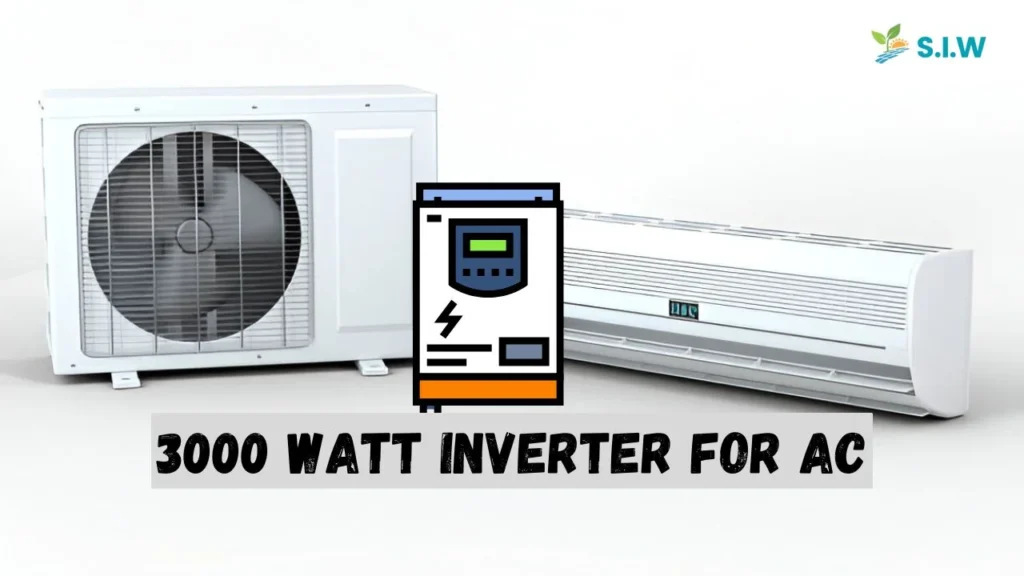In today’s rapidly advancing world of solar energy, using a 3000-watt inverter is a powerful solution to run home or commercial air conditioning (AC) units effectively. Solar-powered systems are becoming essential, with inverters at the core of every setup, as they convert DC power from solar panels into usable AC power for household appliances, including AC units. This article will guide you through everything you need to know about using a 3000-watt inverter for AC in solar-powered setups, discussing its functionality, suitability, advantages, and installation.
What is a 3000-Watt Inverter?
A 3000-watt inverter converts direct current (DC) from solar panels or batteries into alternating current (AC) used by common appliances. It can handle a continuous load of up to 3000 watts, which makes it suitable for running energy-intensive appliances like AC units, refrigerators, and power tools.
Why 3000-Watt Capacity Matters for AC Units
Air conditioners require a high amount of power to start (surge power) and a consistent amount to continue running (continuous power). A 3000-watt inverter can manage both the startup and operating power of medium to large AC units. It’s an ideal size for residential and small commercial air conditioning needs, particularly for locations relying on solar power.
Benefits of a 3000-Watt Inverter for AC in Solar Systems
1. Energy Efficiency and Cost Savings
Integrating a 3000-watt inverter with a solar power system optimizes energy use, drastically cutting down electricity costs. Solar inverters allow for efficient power conversion from the sun, reducing reliance on grid electricity and lowering energy bills significantly.
2. Independence from the Grid
With a solar-powered inverter system, you gain autonomy from the grid, which is invaluable in areas with unstable power supply or in remote locations. A 3000-watt inverter can keep an AC unit running smoothly, ensuring comfort without interruptions.
3. Reduced Environmental Impact
Using a solar inverter system is a green solution. By minimizing dependence on fossil fuels and utilizing renewable energy, a 3000-watt inverter reduces your carbon footprint and contributes to a sustainable future.
Key Components of a Solar System with a 3000-Watt Inverter
To operate an AC unit effectively using a 3000-watt inverter, the solar setup requires several core components:
- Solar Panels: To power a 3000-watt inverter, you need an array that can generate sufficient energy. For example, if you’re in an area with 5 peak sunlight hours per day, a system with around 3000-4000 watts of solar panels is recommended.
- Battery Bank: A battery bank stores energy for use during non-sunny periods. Batteries ensure the AC unit can operate continuously and are particularly useful for running the unit at night.
- Charge Controller: To protect the battery bank from overcharging, a charge controller regulates the flow of energy from solar panels to the batteries. This extends battery life and ensures a stable energy flow to the inverter.
Choosing the Right 3000-Watt Inverter for AC Units
Pure Sine Wave vs. Modified Sine Wave Inverters
When powering an AC, a pure sine wave inverter is typically preferred. Unlike modified sine wave inverters, pure sine wave inverters produce cleaner power, ensuring your AC and other sensitive appliances operate efficiently without the risk of damage.
Off-Grid vs. Hybrid Inverters
For areas entirely independent of grid power, an off-grid inverter is the best choice. If there’s an occasional need for grid electricity, a hybrid inverter allows seamless switching between grid and solar power, adding flexibility and reliability.
Installation Guide for a 3000-Watt Inverter with Solar Power
1. Sizing Your Solar Panels and Battery Bank
Calculate the total daily energy consumption of your AC. For instance, a 3000-watt AC running for 8 hours requires approximately 24 kWh of energy. Your solar panel system should generate enough energy during daylight to cover this usage, plus a bit extra for battery charging.
2. Setting Up the Solar Inverter
Install the 3000-watt inverter in a well-ventilated area to prevent overheating. Connect it directly to the battery bank, following the manufacturer’s instructions for proper wiring and circuit protection.
3. Wiring the Charge Controller
The charge controller should be wired between the solar panels and the battery bank to regulate energy flow, maintaining optimal charging levels without risking battery damage.
4. Connecting the Inverter to the AC Unit
Once the inverter is powered, connect your AC unit. Ensure that all connections are secure and that you have adequate wiring for the load to prevent overheating or energy loss.
Maintenance Tips for a 3000-Watt Inverter Solar Setup
1. Regularly Clean Solar Panels
Keep solar panels clean to maximize their efficiency. Dirt, dust, and debris can reduce panel output by up to 20%.
2. Check Battery Levels
Periodically inspect the battery bank for signs of wear, corrosion, or leaks. Ensure connections are tight and that batteries are charging adequately.
3. Inspect Wiring and Connections
Inverters, like all electrical components, are vulnerable to damage from improper wiring or loose connections. Regular checks help prevent performance issues and extend the system’s lifespan.
Frequently Asked Questions (FAQs)
1. Can a 3000-watt inverter run an air conditioner?
Yes, a 3000-watt inverter can handle the startup surge and continuous power requirements of a typical household AC unit.
2. How many solar panels do I need to run a 3000-watt inverter?
The exact number depends on panel wattage and local sunlight hours. Typically, 3000-4000 watts of solar panels are sufficient in sunny regions.
3. What type of battery is best for an inverter setup?
Lithium-ion batteries are efficient and long-lasting, though lead-acid batteries are also commonly used due to lower upfront costs.
4. Do I need a pure sine wave inverter for my AC?
Yes, a pure sine wave inverter is recommended for running an AC, as it provides clean and stable power.
5. How long will a 3000-watt inverter last with proper maintenance?
With routine care and good installation, a 3000-watt inverter can last 10-15 years.








